Abstract
With the progressive increase in human activities in the Antarctic region, the possibility of domestic oil spillage also increases. Developing means for the removal of oils, such as canola oil, from the environment and waste “grey” water using biological approaches is therefore desirable, since the thermal process of oil degradation is expensive and ineffective. Thus, in this study an indigenous cold-adapted Antarctic soil bacterium, Rhodococcus erythropolis strain AQ5-07, was screened for biosurfactant production ability using the multiple approaches of blood haemolysis, surface tension, emulsification index, oil spreading, drop collapse and “MATH” assay for cellular hydrophobicity. The growth kinetics of the bacterium containing different canola oil concentration was studied. The strain showed β-haemolysis on blood agar with a high emulsification index and low surface tension value of 91.5% and 25.14 mN/m, respectively. Of the models tested, the Haldane model provided the best description of the growth kinetics, although several models were similar in performance. Parameters obtained from the modelling were the maximum specific growth rate (qmax), concentration of substrate at the half maximum specific growth rate, Ks% (v/v) and the inhibition constant Ki% (v/v), with values of 0.142 h−1, 7.743% (v/v) and 0.399% (v/v), respectively. These biological coefficients are useful in predicting growth conditions for batch studies, and also relevant to “in field” bioremediation strategies where the concentration of oil might need to be diluted to non-toxic levels prior to remediation. Biosurfactants can also have application in enhanced oil recovery (EOR) under different environmental conditions.
1. Introduction
Many Antarctic terrestrial ecosystems are dominated by prokaryotes that play vital roles in the food chain, degradation of contaminants and biogeochemical cycles. In recent years, there has been increased appreciation of the biotechnological potential of Antarctic micro-organisms [1,2]. Antarctica is a focus of scientific research and exploration, but the negative impacts of human activity on this region can also be long lasting and have serious consequences for the continent’s native ecosystems. Antarctica is generally considered among the most pristine areas in the world. However, various areas in Antarctica have been contaminated with pollutants, including hydrocarbons [3,4]. Some Antarctic microorganisms produce biosurfactants, which increase biodegradation and the bioavailability of such contaminants. The application of bioremediation approaches in Antarctica, including oil-polluted soils, requires the use of indigenous microorganisms since, in accordance with Antarctic Treaty regulations, it is prohibited to introduce non-native biota [3,5].
Many different species of fungi, yeast and bacteria are capable of degrading hydrocarbons, with bacteria being the best-described biosurfactant producers [6,7,8]. However, details of microbial biosurfactant production remain unclear [9,10]. The bacterial genus Rhodococcus is well-known for its ability to produce large amounts of trehalose lipids, which can act as biosurfactants, reducing water surface tension [11,12].
The description of microbial growth kinetics is an important area in environmental biotechnology [13,14]. Models are used to explain the behaviour of microorganisms under different chemical and physical conditions, clarifying the influence of different variables including, for instance, substrate types, pH and temperature. Such models allow the prediction of substrate inhibition concentration, bacterial growth rate, substrate half saturation constant or half velocity constant and maximum substrate concentration. In order to be able to construct these models, substrate degradation and microbial growth have to be measured and modelled [15].
As happens when exposed to many contaminants, bacterial growth and the degradation of toxic substrates, such as canola oil, are characterised by a lag phase due to the need of the bacterial cells to adapt to the new environmental conditions and initiate degradation pathways. Thus, several growth phases are recognised. Specific growth rate is initially zero during the lag time (λ), after which it enters the exponential phase and reaches a maximum value (qmax). Subsequently, the growth rate drops, eventually to zero, and reaches an asymptote (A) [15].
Modelling growth kinetics of canola oil-degrading bacteria is of great importance. It is often thought that vegetable oils are non-toxic, but studies have shown that lipid biodegradation products can be inhibitory to some micro-organisms, and this may affect the future development of bioremediation approaches. Studies have also shown that high oil concentrations affect the lag phase of bacterial growth, thus having an inhibitory effect on growth and degradation [16,17].
In this study, Rhodococcus erythropolis strain AQ5-07, a soil bacterium previously isolated from King George Island (South Shetland Islands, maritime Antarctic; [18]), was tested for its ability to degrade canola oil and produce biosurfactants, and its growth kinetics were studied and modelled. Canola oil is mostly used in research stations and is use in various cooking techniques, besides it degradation, Rhodococcus erythropolis strain AQ5-07 also could degrade phenol and diesel in addition to heavy metals resistance [3,18,19].
2. Results and Discussion
2.1. Growth and Biosurfactant Production
2.1.1. Haemolytic Activity
Positive haemolytic activity was observed when strain AQ5-07 was screened on red blood agar, which is a widely used indicator of biosurfactant production by micro-organisms [20,21]. Similarly, Ibrahim et al. [22] reported β-haemolysis by the bacteria B. lincheniformis, M. kristinae and S. paucimobilis. The extent of the clear zone formed on the blood agar plate is proportional to the secretion of biosurfactant [23]. However, other confirmatory tests for biosurfactant production are required in the selection of potent biosurfactant producers [24].
2.1.2. Drop Collapse Test
This is an easy and sensitive method to test for biosurfactant production [25]. In this study the Rhodococcus erythropolis supernatant added displaced the oil by 55 mm (Figure 1), indicating a positive drop collapse. Ibrahim et al. [22] reported a greatest oil displacement of 52 mm for S. marcescens, B. lentus by 32 mm, M. kristinae by 20 mm, B. licheniformis 18 mm and 12 mm for B. firmus. Therefore, the degree of drop collapse produced by this strain indicates that its biosurfactant production has the potential to improve any canola oil-degrading performance it has.
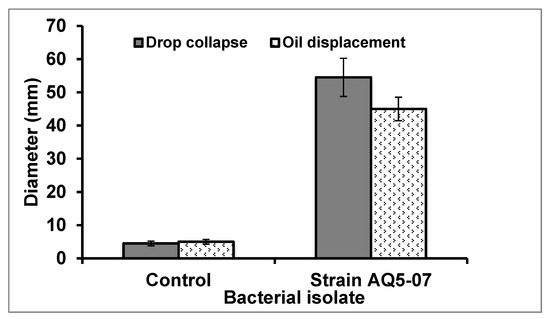
Figure 1.
Drop collapse and oil displacement tests for supernatant fraction from Rhodococcus erythropolis AQ5-07 culture incubated for 72 h. Error bars represent mean ± standard deviation, n = 3.
2.1.3. Oil-Spreading Test
The oil-spreading approach measures the diameter of clear zones formed when a small drop of a biosurfactant-containing solution is placed into an oil layer on the surface of water [25]. There is a correlation between this and the previous drop collapse test. Biosurfactant produced by Rhodococcus erythropolis AQ5-07 culture gave a clear zone of 48 mm diameter in the liquid medium (Figure 1), again confirming the presence of biosurfactant in the cell-free culture broth. The oil displacement area in an oil spreading test is directly proportional to the concentration of a given biosurfactant in the solution [26], although this was not assessed quantitatively in the current study. Ibrahim et al. [22] reported that a 23 mm clear zone diameter was the lowest biosurfactant activity produced by Bacillus licheniformis in liquid medium for crude oil degradation, while Micrococcus kristinae, Serratia marcescens and Pseudomonas paucimobilis produced 51, 38 and 27 mm, respectively.
2.1.4. Surface Tension Measurement
An important criterion used in the selection of biosurfactant-producing organisms is the ability to reduce surface tension to at least 40 mN/m [27]. The surface tension measurement of the cell-free supernatant here showed a considerable reduction, to 25.14 mN/m from 72.1 mN/m, clearly satisfying this criterion. Similarly, Thavasi et al. [24] reported analogous surface tension reduction in five bacterial strains that produced biosurfactants.
2.1.5. Emulsification Activity
This is an indirect technique used to screen biosurfactant production. The idea is that, if the cell-free culture broth used in an assay contains biosurfactant, then it will blend the hydrocarbon present in the test solution. The study strain was able to emulsify the canola oil, which was shown by a clear emulsified layer. Emulsification activity of the cell-free broth cultured in canola oil-containing medium was measured against hexane, hexadecane, tetrahexadecane, toluene and diesel oil. The E24 indices were 91.5%, 88.0%, 80.7%, 52.9% and 62.0%, respectively (Figure 2). Emulsification activity in the presence of toluene and diesel was lower than for the other compounds, which may relate to the lower molecular weight of these compounds [28]. The ability of biosurfactants to emulsify water-hydrocarbon mixtures increases the degradation rate of hydrocarbons in the environment. The existence of hydrocarbon-degrading microbes in seawater allows biological degradation in this medium to be one of the most efficient techniques for contaminant removal [29]. Kumari et al. [30] reported 60.6% and 49.5% petroleum hydrocarbon degradation by biosurfactant producing Rhodococcus sp. NJ2 and Pseudomonas sp. BP10, respectively.
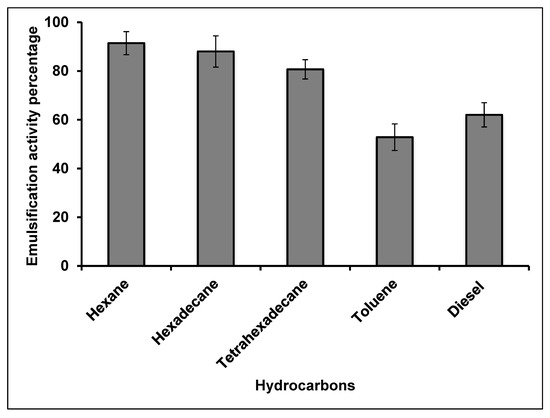
Figure 2.
Emulsification index (E24) for cell-free broth from bacterial cultures after incubation for 72 h. Error bars represent mean ± standard deviation, n = 3.
2.1.6. Microbial Adhesion to Hydrocarbons (MATH) Assay
Rosenberg [31] established the MATH assay, which is now routinely used as a measure of microbial cell surface hydrophobicity. This assay provides an indirect method to screen for biosurfactant production, as the attachment of cells to the oil indicates the presence of surface-active compounds. Following extraction with hexadecane and tetrahexadecane, the strain showed cellular hydrophobicity of 89.6% and 83.6% to these solvents, respectively. This is consistent with Thavasi et al. [24], who reported values of 92.6% and 95.15% as the maximum adhesion to crude oil by Lactobacillus delbrueckii and Pseudomonas aeruginosa, respectively. Zhang et al. [32] similarly reported high cellular hydrophobicities of 81% in diesel for Acinetobacter junii VA2 and 94% for Sphingomonas sp. VA1. Bacterial strains with high cell hydrophobicity values are considered to be potential biosurfactant producers [33].
2.1.7. Stability of Biosurfactant
The emulsification activity index values of the biosurfactant produced by Rhodococcus erythropolis AQ5-07 were measured at different salinity (NaCl), temperature and pH. The effects of salinities of 1–5% (w/v) are illustrated in Figure 3A, and the strain exhibited optimum activity at 2% salinity. The produced biosurfactant might be useful in acidic environmental conditions since it retained activity at pH 2. The emulsification index of the produced biosurfactant was inversely proportional to the salinity, but it still retained high activity at high salinity (3–4%), suggesting that the biosurfactant might be useful in marine environments. Chandran and Das [23] reported a wider salinity range for optimum emulsification activity of 2–10% in Trichosporon asahii. Other studies of biosurfactants produced by bacteria also show stability in presence of high salt concentration [34].
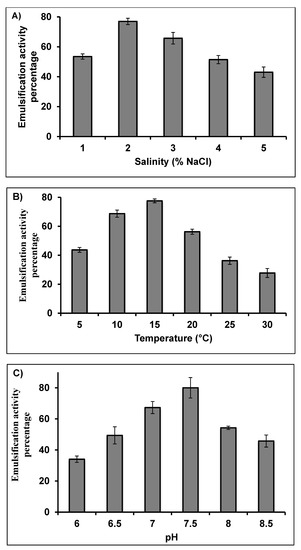
Figure 3.
Effect of (A) salinity, (B) temperature and (C) pH on the emulsification activity of biosurfactant produced by Rhodococcus erythropolis AQ5-07. Error bars represent mean ± standard deviation, n = 3.
The effects of temperature on biosurfactant activity were studied across the range 5–30 °C (Figure 3B). The strain showed highest activity at 10–20 °C, with an optimum of 15 °C. These data suggest that the biosurfactants produced could be suitable for use in relatively low temperature environments and industrial systems. Most maritime Antarctic soil bacteria are psychrotolerant rather than psychrophilic [35], consistent with the scale of thermal variability typically experienced in soil habitats in the summer months in this region [36,37]. Consequently, bioremediation is usually designed and performed in the summertime when soils are unfrozen and liquid water is available. Rhodococcus erythropolis AQ5-07 attained maximum biosurfactant production at 15 °C, confirming that the Antarctic summer soil environment provides appropriate environmental conditions for canola oil remediation by this strain.
Figure 3C shows the effects of pH on emulsification activity over a pH range of 6–8.5. The strain showed highest activity at pH 7.5, with activity decreasing rapidly at both more alkaline and acidic pH. This could be caused by increased stability of fatty acid-surfactant micelles in the presence of NaOH and the precipitation of secondary metabolites at higher pH values. Chandran and Das [23] reported optimum pH for emulsification activity by Trichoporon asahii to be 2–6.
2.2. Optimisation of Crude Biosurfactant Production
Biosurfactant production was optimised in a batch system under facultative aerobic conditions where pH, temperature and initial canola oil substrate concentration were varied. When grown in minimal salt media at pH 7.5, the strain produced maximum biosurfactant levels when incubated at 15 °C and an initial substrate concentration of 3% (v/v) (Figure 4). When the incubation temperature was increased to more than 20 °C, bacterial growth and biosurfactant production were inhibited. Chandran and Das [23] reported maximum production of biosurfactant by the tropical species Trichosporon asahii at pH 7.5 and 35 °C. Similarly, Hamzah et al. [38] and Chen et al. [39] reported that the optimum temperature for biosurfactant production by P. aeruginosa UKM14T and P. aeruginosa S2 was 37 °C. In contrast with these strains, psychrotolerant and psychrophilic bacteria typically have growth optima below 15–20 °C.
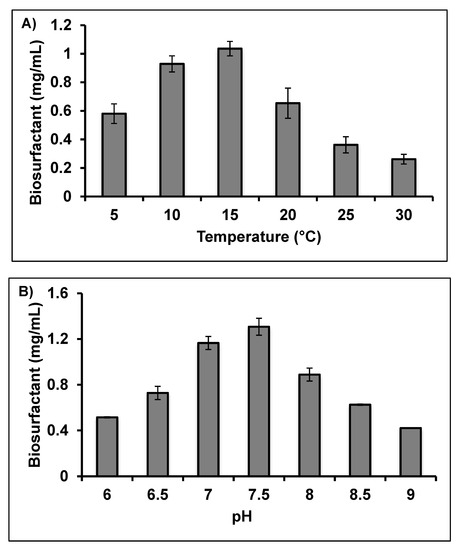
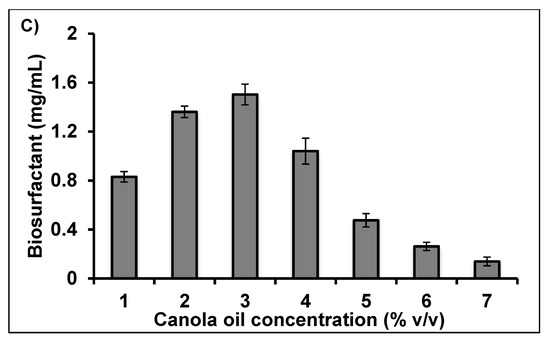
Figure 4.
Effect of different environmental variables, (A) temperature, (B) pH and (C) canola oil concentrations on the biosurfactant produced by Rhodococcus erythropolis AQ5-07. Error bars represent mean ± standard deviation, n = 3.
Production of crude biosurfactant was maximum during the initial stationary phase at 72 h under all tested culture conditions. During this phase, a high concentration of crude biosurfactant was produced, which may be attributed to the discharge of cell-bound biosurfactant into the culture broth thereby increasing the extracellular biosurfactant concentration [23]. Biosurfactants are mainly produced during the early stationary phase and then remain up to the death phase. The surface tension values continue to decline until the point of critical micelle concentration where no further decrease would occur. The cause of the increase in surface tension of cultures might possibly be due to the degradation of biosurfactant in the culture media or consumption of biosurfactant for microbial survival [22].
2.3. Growth on Canola Oil Modelled Using Secondary Models
Bacterial growth kinetics were obtained by measuring the rate of bacterial growth over 72 h at different initial oil concentrations (Figure 5). Bacterial growth initially increased with oil concentration, reaching an optimum at initial concentration 3% (v/v), subsequently decreasing at concentrations higher than 3.5% (v/v) and being inhibited at 7% (v/v). The results were used to calculate the bacterial growth rate. The slope represents the growth rate, and this was plotted against the initial concentration canola oil.
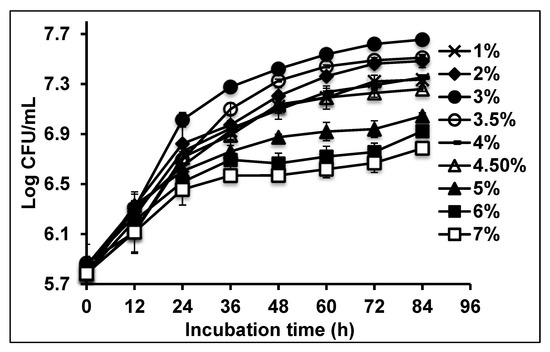
Figure 5.
Effect of different initial canola oil concentrations on growth in Rhodococcus erythropolis AQ5-07. Error bars represent mean ± standard deviation, n = 3.
The relationship between the specific growth rate (q) of a microbial population and the concentration of canola oil substrate (S) is a valuable tool in biotechnological applications. This relationship is described by various theoretical models [40,41]. In the current study there was an increase in cell growth rate with increasing initial canola oil concentration up 3% (v/v) and then a decrease at higher concentrations, indicating the inhibitory effect of canola oil. The data from the batch analyses were fitted to seven kinetics models (Figure 6).
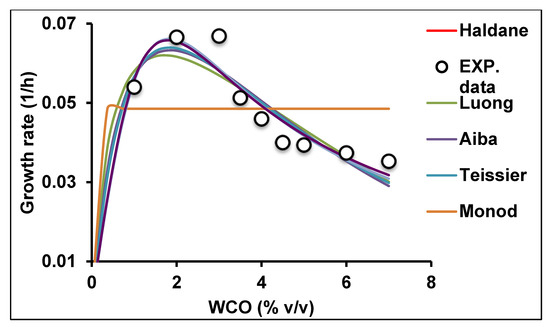
Figure 6.
Modelling of bacterial growth kinetic experimental values using seven different kinetic models.
The statistical analysis and accuracy of the kinetics models used showed that technically the best fitting model was Haldane, with the highest values for adjusted R2, R2, AF and BF nearest to unity (1.0) and the lowest value for AICc, RMSE (Table 1). However, most other models showed good and very similar fits, as illustrated in Figure 6, with the exception of Monod. The calculated values for the Haldane model constants maximum specific growth rate (qmax), half saturation constant (Ks) and growth inhibition constant (Ki) were 0.142 h−1, 7.743% (v/v) and 0.399% (v/v), respectively. The equation for the Haldane model was:

Table 1.
Statistical analyses of waste canola oil growth kinetics models.
The Haldane model is widely used due to its simplicity and ability to describe substrate growth inhibition kinetics by integrating substrate and growth-inhibition constants. The model is also based on a single continuous fermentation to the point of growth inhibition at high substrate concentration [42].
Most previous studies on the effects of substrate on microbial growth that have been carried out using non-toxic substrates have utilised the Monod kinetic model, whereas studies using toxic substrates such as phenol, cadmium, molybdenum, mercury, caffeine and polyethylene glycol have used one or more of the other kinetics models listed in Table 2 [41,43,44]. Data obtained in the current study demonstrate that the growth rate of this bacterium was inhibited at high canola oil concentrations.
Wayman and Tseng [45] reported that other models addressing substrate inhibition kinetics also exist, including discontinuous models. These were developed because models such as Haldane, Webb, Andrews and Noack could explain inhibitory effects on microbial growth but could not explain or adequately model certain conditions where the growth rate became zero at very high substrate concentration. Nonetheless, the major drawback of such discontinuous models remains that they cannot predict Sm [46].
The use of these models in studies of the kinetics of microbial vegetable oil-degrading processes is rare because of the perceived non-toxicity of vegetable oil. However, some studies have shown that soluble lipid biodegradation products can be inhibitory, at least to certain degrading organisms, and this is pertinent to designing future bioremediation protocols [16,17]. The Haldane model has previously been used in modelling hydrocarbon degradation [47], but this is the first time that it has been utilised to model bacterial growth kinetics using canola oil as a substrate.
3. Materials and Methods
3.1. Microorganism and Shake Flask Culture Condition
Previously isolated Rhodococcus erythropolis AQ5-07 originally obtained from King George Island (South Shetland Islands, Antarctica) was streaked on Tween-peptone agar ((mg/L): 100 CaCl2, 5000 NaCl, 10,000 peptone, 18,000 agar and 5 mL/L of Tween 80) [48] and incubated at 10 °C for 72 h. Single colony was transferred to 100 mL canola oil liquid medium ((mg/L): 300 yeast extract, 1000 (NH4)2SO4, 200 MgSO4·7H2O, 600 KH2PO4 and 900 K2HPO4) supplemented with 3% waste canola oil (obtained from Chilean Bernardo O’Higgins Riquelme Station, northern Antarctic Peninsula, in February 2018) and grown at 10 °C and 150 rpm for 24 h [19]. Bacterial culture (10%) was then transferred to 100 mL of the canola oil medium in 250 mL Erlenmeyer flasks and incubated for 72 h at 150 rpm and 10 °C. After 72 h, 1 mL of sample was removed and centrifuged at 12,000 rpm for 10 min, after which cell biomass was measured. All experiments were done in triplicates.
3.2. Biosurfactant Analysis
Rhodococcus erythropolis AQ5-07 was screened for biosurfactant production based on haemolytic activity, drop collapse, oil spreading test, surface tension, emulsification index activity and microbial adhesion to hydrocarbon assay. In addition, the stability of the biosurfactant produced was also assessed and optimised.
3.2.1. Haemolytic Activity
The haemolytic activity of Rhodococcus erythropolis AQ5-07 was determined by streaking the bacterium, 20 µL onto sheep blood agar plate containing 5% (v/v) and incubation at 15 °C for 48–72 h [49].
3.2.2. Drop Collapse Test
This test was done using mineral oil as hydrocarbon substrate as described by Youssef et al. [25] with some modifications. Supernatant liquid was obtained by centrifuging bacterial culture at 12,000 rpm for 10 min. Then, a mineral oil drop (10 μL) was set on a grease-free glass slide followed by drops of the supernatant being placed onto the centre of the oil drop. Drop collapse was measured by observing the shape of the drop after 1 min. Water was used as a negative control.
3.2.3. Oil-Spreading Test
The oil spreading test was conducted as explained by Rodrigues et al. [50]. Briefly, 100 μL of used engine oil was added to Petri dishes containing 50 mL dH2O, forming a thin layer on the surface. Then, 10 μL of cell-free culture supernatant and water (control) were carefully added to the oil surface. Following 30 s incubation, the diameter of the clear zone was measured and compared with the negative control.
3.2.4. Emulsification Index Test
Emulsifying ability of the bacterium was estimated by calculating an emulsification index (E24) for hexadecane and diesel. To do so, 4 mL of each of hexane, hexadecane, tetrahexadecane, toluene and diesel were added to an equal volume of 4 mL of supernatant (cell-free) broth in a test tube. The resulting mixture was vortexed at high speed for 5 min and allowed to stand for 24 h. The emulsification activity index E24 was estimated following Shoeb et al. [49].
3.2.5. Surface Tension
The surface tension was measured as described by Thavasi et al. [24]. The surface tension of the supernatant was determined using tensiometer (VCA 3000 Water surface analysis system, Billerica, MA, USA). Distilled water was used as a control.
3.2.6. Microbial Adhesion to Hydrocarbon (MATH) Assay
The cellular hydrophobicity of Rhodococcus erythropolis AQ5-07 was measured following Zoueki et al. [51] and Rosenberg [31] with some modifications. Briefly, 24 h grown bacterial culture was collected, washed and rinsed twice with saline phosphate buffer (pH 7.4). The bacteria were then re-suspended to an absorbance (OD600 nm) of 1 on a spectrophotometer (U.V mini 1240 Shimadzu, Japan). Next, 300 µL of each of tetrahexadecane and hexadecane were added to 5 mL bacterial cell suspension in a clean borosilicate round-bottom glass tube. The mixture in the tube was vortexed for 2 min and set to stand for 15 min to allow tetrahexadecane and hexadecane to be separated from the aqueous phase. The aqueous phase was carefully removed, and absorbance was measured at 600 nm.
3.2.7. Biosurfactant Stability Test
Obayori et al. [34] method was used to determine the biosurfactant stability of the isolate. Briefly, the cell-free broth (supernatant) was obtained by centrifuging bacterial culture at 12,000 rpm for 10 min. The pH of the collected supernatant was adjusted to 6.5, 7.0, 7.5 or 8.0, followed by the E24 determination. The temperature stability of the biosurfactant was also studied, measuring the E24 at various temperatures (5, 10, 15, 20 and 25 °C). The effects of different NaCl concentrations on biosurfactant stability were studied at concentrations of 2%, 3%, 4% and 5% (w/v).
3.2.8. Optimisation of Biosurfactant Production
The bacterial strain was cultured at different temperatures ranging from 5–30 °C, initial substrate concentration of 0.5–5% (v/v) canola oil and pH ranging from 6 to 8. All experiments were carried out in triplicate. The cultures were maintained for 72–96 h at 150 rpm.
3.2.9. Biosurfactant Extraction
The biosurfactant produced in the course biodegradation of canola oil was extracted using the method of Patowary et al. [52] with some little modification. For the extraction of biosurfactant, bacterial cells free supernatant was removed by centrifugation 10,000× g for 10 min at 4 °C. The cell free supernatant was acidified with 2 N HCl to reduce the pH to 2.0. This was then followed by extraction using chloroform and methanol (2:1 v/v) by vigorous shaking and allowed to stand for a few minutes until phase separation. The extracts were concentrated by removing the solvents using rotatory evaporator and then sodium sulphate anhydrous was added to remove water, producing crude biosurfactant as the resultant residue. Weight of the produced biosurfactant was evaluated and expressed in terms of milligram per millilitre (dry weight) [22].
where XY is the dry weight of biosurfactant, AB is the weight of plate and CD is biosurfactant residue after drying, while XYZ is weight of the empty plate.
3.3. Bacterial Growth Kinetics Modelling
The bacterium was cultivated under optimum conditions for canola oil degradation in nutrient broth (to an OD600 of 1.3–1.4) [19] on an incubator shaker at 10 °C and 150 rpm for 84 h. About 10% (v/v) of the seed cultures were transferred to 100 mL of canola oil liquid medium containing initial canola oil concentrations ranging from 1%–7%. Following 12 h incubation under the same conditions, 1 mL aliquots from the culture medium were collected at 12 h intervals until 84 h and cell growth and canola oil degradation were measured [53]. The determination of the canola oil degradation kinetic variables was not possible because of the liquid nature of the oil. Therefore, only bacterial growth kinetics were studied.
Various kinetics models were used to model bacterial growth kinetics (Table 2). Kinetics modelling was carried out using bacterial growth data obtained with different initial canola oil concentrations over time. The model factors were assessed using non-linear regression and the Levenberg–Marquardt algorithm using CurveExpert Professional software (Version 2.6.5). qmax estimation was made using a steepest gradient search of the curve among the four datum points.

Table 2.
Mathematical models developed for growth kinetics studies involving different substrate concentrations and conditions.
Table 2.
Mathematical models developed for growth kinetics studies involving different substrate concentrations and conditions.
| Model | Equation | No. of Parameters | References |
|---|---|---|---|
| Monod | 2 | [54] | |
| Haldane | 3 | [55] | |
| Teissier | 3 | [56] | |
| Luong | 4 | [57] | |
| Aiba | 4 | [58] | |
| Yano and Koga | 4 | [59] | |
| Webb | 4 | [60] |
Note: qmax: Maximum cell growth and degradation rate (h−1); Ks: Half saturation constant or half velocity constant (% v/v); Ki: Inhibition constant (% v/v); S: Substrate concentration (% v/v); Sm: Maximum concentration of substrate tolerated (% v/v); m, n, K: Curve parameters.
Verification of the Models
The fit of the models was verified using statistical analyses assessing the adjusted coefficient of determination (R2), root-mean-square error (RMSE), bias factor (BF), accuracy factor (AF), sum of squares errors (SSE) and corrected Akaike information criterion (AICc) [61].
4. Conclusions
We document that the Antarctic bacterium Rhodococcus erythropolis AQ5-07 is a potent biosurfactant producer and efficient canola oil degrader. The biosurfactant has high hydrophobicity, emulsification activity and low surface tension value, as well as positive drop collapse oil spreading test result. The strain was able to produce biosurfactant under optimum conditions of 2% NaCl, pH 7.5 and 15 °C. The Haldane kinetic model gave the best fit to the experimental data obtained, with lowest values of AICc, RMSE, SSE and highest R2 value, although similar overall to several other models tested. This cold-tolerant bacterium’s features make it a plausible candidate to be used for on-site bioremediation of vegetable oil-contaminated sites under low temperature.
Author Contributions
Conceptualization, S.A.A. (Siti Aqlima Ahmad); methodology, A.Z., C.G.-F. and S.S.; Software, S.I.; validation, P.C. and S.A.A. (Siti Aqlima Ahmad); formal analysis, S.I. and K.N.M.Z.; investigation, S.I., K.A.K. and G.G.-R.; resources, S.A.A. (Siti Aqlima Ahmad) and S.A.A. (Siti Aisyah Alias); data curation, A.Z.; original draft preparation, S.I. and K.N.M.Z.; writing—review and editing, S.I., K.N.M.Z., S.A.A. (Siti Aqlima Ahmad), K.A.K., P.C. and S.S.; visualization, S.A.A. (Siti Aqlima Ahmad); supervision, S.A.A. (Siti Aqlima Ahmad), K.A.K. and S.S.; project administration, S.A.A. (Siti Aqlima Ahmad); funding acquisition, S.A.A. (Siti Aqlima Ahmad). All authors have read and agreed to the published version of the manuscript.
Funding
This work was supported by Matching Grant PUTRA (UPM 9300436), PUTRA Berimpak (9660000 and 9678900), YPASM Smart Partnership Initiative 2019 (6300247), Centro de Investigacion y Monitoreo Ambiental Antàrctico (CIMAA) and National Antarctic Research Centre (NARC). We acknowledge Universiti Putra Malaysia, Chilean Army and the Antarctic General Bernardo O’Higgins Station staff especially the Comandante de la Base O’Higgins; Teniente Coronel Jose Ignacio Alvarado Camps, staff especially the Chef; Suboficial Juan David Sandoval Navarrete and Sargento Juan Eduardo Cortínez Padovani for providing an enabling environment to conduct the research. P. Convey is supported by NERC core funding to the British Antarctic Survey ‘Biodiversity. Evolution and Adaptation’ Team. We would also like to thank Nancy Calisto-Ulloa (Universidad de Magallanes) for assistance.
Conflicts of Interest
The authors declare no conflict of interest.
References
- Subramaniam, K.; Mazuki, T.A.T.; Shukor, M.Y.; Ahmad, S.A. Isolation and optimisation of phenol degradation by Antarctic isolate using ine factor at time. Malays. J. Biochem. Mol. Biol. 2019, 1, 79–86. [Google Scholar]
- Tengku-Mazuki, T.A.; Subramanian, K.; Zakaria, N.N.; Convey, P.; Khalil, K.A.; Lee, G.L.Y.; Zulkharnain, A.; Shaharuddin, N.A.; Ahmad, S.A. Optimization of phenol degradation by Antarctic bacterium Rhodococcus sp. Antarct. Sci. 2020, 10, 1–10. [Google Scholar] [CrossRef]
- Roslee, A.F.A.; Zakaria, N.N.; Convey, P.; Zulkharnain, A.; Lee, G.L.Y.; Gomez-Fuentes, C.; Ahmad, S.A. Statistical optimisation of growth conditions and diesel degradation by the Antarctic bacterium, Rhodococcus sp. strain AQ5‒07. Extremophiles 2020, 24, 277–291. [Google Scholar] [CrossRef] [PubMed]
- Abdulrasheed, M.; Zakaria, N.N.; Ahmad Roslee, A.F.; Shukor, M.Y.; Zulkharnain, A.; Napis, S.; Convey, P.; Alias, S.A.; Gonzalez-Rocha, G.; Ahmad, S.A. Biodegradation of diesel oil by cold-adapted bacterial strains of Arthrobacter spp. from Antarctica. Antarct. Sci. 2020, 13, 1–13. [Google Scholar] [CrossRef]
- Zakaria, N.N.; Roslee, A.F.A.; Gomez-Fuentes, C.; Zulkharnain, A.; Abdulrasheed, M.; Sabri, S.; Ramírez-Moreno, N.; Calisto-Ulloa, N.; Ahmad, S.A. Kinetic studies of marine psychrotolerant microorganisms capable of degrading diesel in the presence of heavy metals. Rev. Mex. Ing. Química 2020, 19, 1375–1388. [Google Scholar] [CrossRef]
- Kaczorek, E.; Chrzanowski, L.; Pijanowska, A.; Olszanoswski, A. Yeast and bacteria cell hydrophobicity and hydrocarbon biodegradation in the presence of natural surfactants: Rhamnolipids and saponins. Bioresour. Technol. 2008, 99, 4285–4291. [Google Scholar] [CrossRef]
- Sáenz-Marta, C.I.; de Lourdes Ballinas-Casarrubias, M.; Rivera-Chavira, B.E.; Nevárez-Moorillón, G.V. Biosurfactants as useful tools in bioremediation. IntechOpen 2015, 2, 1–19. [Google Scholar] [CrossRef]
- Zakaria, N.N.; Man, Z.; Zulkharnain, A.; Ahmad, S.A. Psychrotolerant biosurfactant-producing bacteria for hydrocarbon degradation: A mini review. Malays. J. Biochem. Mol. Biol. 2019, 22, 52–59. [Google Scholar]
- Ilory, M.; Adebusoye, E.; Ojo, A. Isolation and characterization of hydrocarbon-degrading and biosurfactant-producing yeast strains obtained from a polluted lagoon water. World J. Microbiol. Biotechnol. 2008, 24, 2539–2545. [Google Scholar] [CrossRef]
- Abouseoud, M.; Maachi, R.; Amrane, A.; Boudergua, S.; Nabi, A. Evaluation of different carbon and nitrogen sources in production of biosurfactant by Pseudomonas fluorescens. Desalination 2008, 223, 143–151. [Google Scholar] [CrossRef]
- Kügler, J.H.; Le Roes-Hill, M.; Syldatk, C.; Hausmann, R. Surfactants tailored by the class Actinobacteria. Front. Microbiol. 2015, 6, 5–23. [Google Scholar] [CrossRef]
- Perfumo, A.; Banat, I.M.; Marchant, R. Going green and cold: Biosurfactants from low-temperature environments to biotechnology applications. Trends Biotechnol. 2018, 36, 277–289. [Google Scholar] [CrossRef] [PubMed]
- Zahri, N.K.M.; Zulkharnain, A.; Ibrahim, S.; Gomez-fuentes, C.; Sabri, S.; Nancy, C.-U.; Ahmad, S.A. Kinetic analysis on the effects of lead (Pb) and silver (Ag) on waste canola oil (WCO) biodegradation by selected Antarctic microbial consortium. Malays. J. Biochem. Mol. Biol. 2020, 1, 20–23. [Google Scholar]
- Zakaria, N.N.; Roslee, A.F.A.; Zulkharnain, A.; Gomez-Fuentes, C.; Abdulrasheed, M.; Sabri, S.; Calisto-Ulloa, N.; Ahmad, S.A. Bacterial growth and diesel biodegradation in the presence of As, Cu and Pb by Antarctic marine bacteria. Malays. J. Biochem. Mol. Biol. 2019, 22, 1–7. [Google Scholar]
- Zwietering, M.H.; Jongenburger, I.; Rombouts, F.M.; Van’t Riet, K. Modeling of the bacterial growth curve. Appl. Environ. Microbiol. 1990, 56, 1875–1881. [Google Scholar] [CrossRef] [PubMed]
- Mercurio, P.; Burns, K.A.; Negri, A. Testing the ecotoxicology of vegetable versus mineral based lubricating oils: 1. Degradation rates using tropical marine microbes. Environ. Pollut. 2004, 129, 165–173. [Google Scholar] [CrossRef]
- Campo, P.; Zhao, Y.; Suidan, M.T.; Venosa, A.D.; Sorial, G.A. Biodegradation kinetics and toxicity of vegetable oil triacylglycerols under aerobic conditions. Chemosphere 2007, 68, 2054–2062. [Google Scholar] [CrossRef]
- Lee, G.L.Y.; Ahmad, S.A.; Yasid, N.A.; Zulkharnain, A.; Convey, P.; Wan Johari, W.L.; Alias, S.A.; Gonzalez-Rocha, G.; Shukor, M.Y. Biodegradation of phenol by cold-adapted bacteria from Antarctic soils. Polar Biol. 2018, 41, 553–562. [Google Scholar] [CrossRef]
- Ibrahim, S.; Zulkharnain, A.; Zahri, K.N.M.; Lee, G.L.Y.; Convey, P.; Gomez-Fuentes, C.; Sabri, S.; Khalil, K.A.; Gonazalez-Rocha, G.; Ahmad, S.A. Effect of heavy metals and other xenobiotics on biodegradation of waste canola oil by cold-adapted Rhodococcus sp. AQ5-07. Rev. Mex. Ing. Química 2020, 19, 1041–1052. [Google Scholar] [CrossRef]
- Mulligan, C.N. Environmental applications for biosurfactants. Environ. Pollut. 2005, 133, 183–198. [Google Scholar] [CrossRef]
- Yonebayashi, H.; Yoshida, S.; Ono, K.; Enomoto, H. Screening of microorganisms for microbial enhanced oil recovery processes. J. Japan Pet. Inst. 2000, 43, 59–69. [Google Scholar] [CrossRef]
- Ibrahim, M.L.; Ijah, U.J.J.; Manga, S.B.; Bilbis, L.S.; Umar, S. Production and partial characterization of biosurfactant produced by crude oil degrading bacteria. Int. Biodeterior. Biodegrad. 2013, 81, 28–34. [Google Scholar] [CrossRef]
- Chandran, P.; Das, N. Biosurfactant production and diesel oil degradation by yeast species Trichosporon asahii isolated from petroleum hydrocarbon contaminated soil. Int. J. Eng. Sci. Technol. 2010, 2, 6942–6953. [Google Scholar]
- Thavasi, R.; Sharma, S.; Jayalakshmi, S. Evaluation of screening methods for the isolation of biosurfactant producing marine bacteria. J. Pet. Environ. Biotechnol. 2011, 4, 1–6. [Google Scholar] [CrossRef]
- Youssef, N.H.; Duncan, K.E.; Nagle, D.P.; Savage, K.N.; Knapp, R.M.; McInerney, M.J. Comparison of methods to detect biosurfactant production by diverse microorganisms. J. Microbiol. Methods 2004, 56, 339–347. [Google Scholar] [CrossRef]
- Morikawa, M.; Hirata, Y.; Imanaka, T. A study on the structure-function relationship of lipopeptide biosurfactants. Biochim. Biophys. Acta 2000, 1488, 211–218. [Google Scholar] [CrossRef]
- Bodour, A.A.; Miller-Maier, R.M. Application of a modified drop-collapse technique for surfactant quantitation and screening of biosurfactant-producing microorganisms. J. Microbiol. Methods 1998, 32, 273–280. [Google Scholar] [CrossRef]
- Morais, I.M.C.; Cordeiro, A.L.; Teixeira, G.S.; Domingues, V.S.; Nardi, R.M.D.; Monteiro, A.S.; Alves, R.J.; Siqueira, E.P.; Santos, V.L. Biological and physicochemical properties of biosurfactants produced by Lactobacillus jensenii P6A and Lactobacillus gasseri P65. Microb. Cell Fact. 2017, 16, 1–15. [Google Scholar] [CrossRef]
- Banat, I.M.; Makkar, R.S.; Cameotra, S.S. Potential commercial applications of microbial surfactants. Appl. Microbiol. Biotechnol. 2000, 53, 495–508. [Google Scholar] [CrossRef]
- Kumari, B.; Singh, S.N.; Singh, D.P. Characterization of two biosurfactant producing strains in crude oil degradation. Process Biochem. 2012, 47, 2463–2471. [Google Scholar] [CrossRef]
- Rosenberg, M. Bacterial adherence to hydrocarbons: A useful technique for studying cell surface hydrophobicity. FEMS Microbiol. Lett. 1984, 22, 289–295. [Google Scholar] [CrossRef]
- Zhang, Q.; Wang, D.; Li, M.; Xiang, W.N.; Achal, V. Isolation and characterization of diesel degrading bacteria, Sphingomonas sp. and Acinetobacter junii from petroleum contaminated soil. Front. Earth Sci. 2014, 8, 58–63. [Google Scholar] [CrossRef]
- Volchenko, N.N.; Karasev, S.G.; Nimchenko, D.V.; Karaseva, E.V. Cell hydrophobicity as a criterion of selection of bacterial producers of biosurfactants. Microbiology 2007, 76, 112–114. [Google Scholar] [CrossRef]
- Obayori, O.S.; Ilori, M.O.; Adebussoye, S.A.; Oyetibo, G.O.; Omoayo, A.E.; Amund, O.O. Degradation of hydrocarbons an biosurfactant production by Pseudomonas sp. strain LP1. World J. Microbiol. Biotechnol. 2009, 25, 1615–1623. [Google Scholar] [CrossRef]
- Helmke, E.; Weyland, H. Psychrophilic versus psychrotolerant bacteria-occurrence and significance in polar and temperate marine habitats. Cell. Mol. Biol. 2004, 50, 553–561. [Google Scholar] [CrossRef] [PubMed]
- Peck, L.S.; Convey, P.; Barnes, D.K.A. Environmental constraints on life histories in Antarctic ecosystems: Tempos, timings and predictability. Biol. Rev. 2006, 81, 75–109. [Google Scholar] [CrossRef]
- Convey, P.; Coulson, S.J.; Worland, M.R.; Sjöblom, A. The importance of understanding annual and shorter-term temperature patterns and variation in the surface levels of polar soils for terrestrial biota. Polar Biol. 2018, 41, 1587–1605. [Google Scholar] [CrossRef]
- Hamzah, A.; Sabturani, N.; Radiman, S. Screening and optimization of biosurfactant production by the hydrocarbon-degrading bacteria. Sains Malays. 2013, 42, 615–623. [Google Scholar] [CrossRef]
- Chen, S.Y.; Lu, W.B.; Wei, Y.H.; Chen, W.M.; Chang, J.S. Improved production of biosurfactant with newly isolated Pseudomonas aeruginosa S2. Biotechnol. Prog. 2007, 23, 661–666. [Google Scholar] [CrossRef]
- Ahmad, S.A.; Ibrahim, S.; Shukor, M.Y.; Johari, W.L.W.J.; Rahman, N.A.; Syed, M.A.S. Biodegradation kinetics of caffeine by Leifsonia sp. strain SIU. J. Chem. Pharm. Sci. 2015, 8, 312–316. [Google Scholar]
- Ibrahim, S.; Shukor, M.Y.; Syed, M.A.; Wan Johari, W.L.; Ahmad, S.A. Characterisation and growth kinetics studies of caffeine-degrading bacterium Leifsonia sp. strain SIU. Ann. Microbiol. 2016, 66, 289–298. [Google Scholar] [CrossRef]
- Agarwal, R.; Mahanty, B.; Dasu, V.V. Modeling growth of Cellulomonas cellulans NRRL B 4567 under substrate inhibition during Cellulase production. Chem. Biochem. Eng. Q. 2009, 23, 213–218. [Google Scholar]
- Agarry, S.E.; Solomon, B.O. Kinetics of batch microbial degradation of phenols by indigenous Pseudomonas fluorescence. Int. J. Environ. Sci. Technol. 2008, 5, 223–232. [Google Scholar] [CrossRef]
- Othman, A.R.; Bakar, N.A.; Halmi, M.I.E.; Johari, W.L.W.; Ahmad, S.A.; Jirangon, H.; Syed, M.A.; Shukor, M.Y. Kinetics of molybdenum reduction to molybdenum blue by Bacillus sp. strain A.rzi. BioMed Res. Int. 2013, 2013, 1–9. [Google Scholar] [CrossRef] [PubMed]
- Wayman, M.; Tseng, M.C. Inhibition threshold substrate concentrations. Biotechnol. Bioeng. 1976, 18, 383–387. [Google Scholar] [CrossRef]
- Mulchandani, A.; Luong, J.H.T.; Groom, C. Substrate inhibition kinetics for microbial growth and synthesis of poly-β-hydroxybutyric acid by Alcaligenes eutrophus ATCC 17697. Appl. Microbiol. Biotechnol. 1989, 30, 11–17. [Google Scholar] [CrossRef]
- Ahmad, S.A.; Ku Ahamad, K.N.E.; WanJohari, W.L.; Halmi, M.I.E.; Shukor, M.Y.; Yusof, M.T. Kinetics of diesel degradation by an acrylamide-degrading bacterium. Rend. Lincei 2014, 25, 505–512. [Google Scholar] [CrossRef]
- Rajan, A.; Kumar, S.; Nair, A.J. Isolation of novel alkaline lipase producing fungus Aspergillus fumigatus MTCC 9657 from aged and crude rice bran oil and quantification by HPTLC. Int. J. Biol. Chem. 2011, 5, 116–126. [Google Scholar] [CrossRef]
- Shoeb, E.; Ahmed, N.; Akhter, J.; Badar, U.; Siddiqui, K.; Ansari, F.A.; Waqar, M.; Imtiaz, S.; Akhtar, N.; Shaikh, Q.U.A.; et al. Screening and characterization of biosurfactant-producing bacteria isolated from the Arabian Sea coast of Karachi. Turk. J. Biol. 2015, 39, 210–216. [Google Scholar] [CrossRef]
- Rodrigues, L.; Banat, I.M.; Teixeira, J.; Oliveira, R. Biosurfactants: Potential applications in medicine. J. Antimicrob. Chemother. 2006, 57, 609–618. [Google Scholar] [CrossRef]
- Zoueki, C.W.; Tufenkji, N.; Ghoshal, S. A modified microbial adhesion to hydrocarbons assay to account for the presence of hydrocarbon droplets. J. Colloid Interface Sci. 2010, 344, 492–496. [Google Scholar] [CrossRef] [PubMed]
- Patowary, K.; Patowary, R.; Kalita, M.C.; Deka, S. Characterization of biosurfactant produced during degradation of hydrocarbons using crude oil as sole sole of carbon. Front. Microbiol. 2017, 8, 2–14. [Google Scholar] [CrossRef] [PubMed]
- Karamba, K.I.; Aqlima, S.A.; Zulkharnain, A.; Yasid, N.A.; Ibrahim, S.; Shukor, M.Y. Batch growth kinetic studies of locally isolated cyanide-degrading Serratia marcescens strain AQ07. 3 Biotech 2018, 8, 1–9. [Google Scholar] [CrossRef] [PubMed]
- Monod, J. The growth of bacterial cultures. Annu. Rev. Microbiol. 1949, 3, 371–394. [Google Scholar] [CrossRef]
- Haldane, J.B.S. Enzymes; Longmans, Green & Co: London, UK, 1930. [Google Scholar]
- Teissier, G. Croissance des populations bacte’riennes et quantite’d’aliment disponible (Growth of bacterial populations and the available substrate concentration). Revis. Sci. 1942, 80, 209. [Google Scholar]
- Luong, J.H.T. Generalization of Monod kinetics for analysis of growth data with substrate inhibition. Biotechnol. Bioeng. 1987, 29, 242–248. [Google Scholar] [CrossRef]
- Aiba, S.; Shoda, M.; Nagalani, M. Kinetics of product inhibition in alcohol fermentation. Biotechnol. Bioeng. 1968, 10, 845–864. [Google Scholar] [CrossRef]
- Yano, T.; Koga, S. Dynamic behavior of the chemostat subject to substrate inhibition. Biotechnol. Bioeng. 1969, 11, 139–153. [Google Scholar] [CrossRef]
- Webb, J.L. Enzymes and Metabolic Inhibitors; Academic Press: Boston, MA, USA, 1963. [Google Scholar]
- López, S.; Prieto, M.; Dijkstra, J.; Dhanoa, M.S.; France, J. Statistical evaluation of mathematical models for microbial growth. Int. J. Food Microbiol. 2004, 96, 289–300. [Google Scholar] [CrossRef]
Sample Availability: Samples of the compounds are not available from the authors. |
© 2020 by the authors. Licensee MDPI, Basel, Switzerland. This article is an open access article distributed under the terms and conditions of the Creative Commons Attribution (CC BY) license (http://creativecommons.org/licenses/by/4.0/).